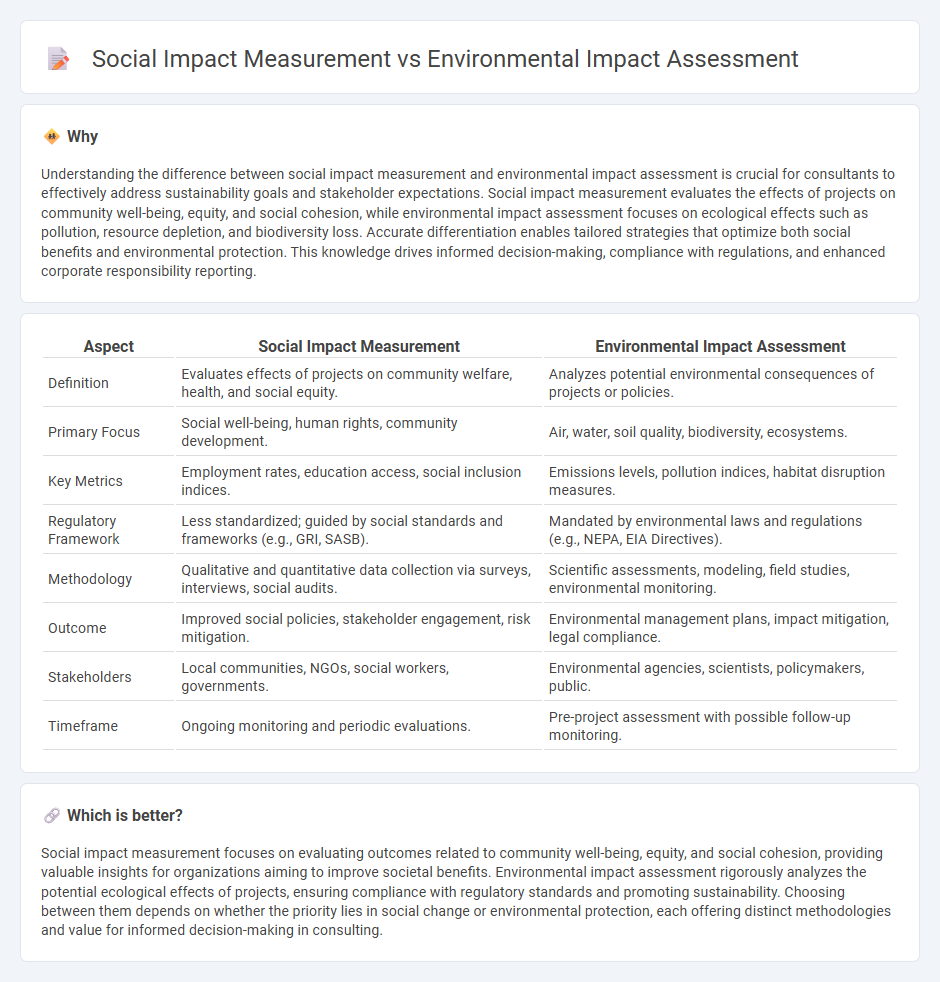
Consulting in social impact measurement focuses on evaluating the effects of projects or policies on communities' well-being, social equity, and human rights, using tools like Social Return on Investment (SROI) and stakeholder analysis. Environmental impact assessment (EIA) examines the potential effects of developments on ecosystems, biodiversity, air, and water quality, employing methods such as baseline studies and mitigation planning. Explore our services to understand how expert consulting can optimize both social and environmental outcomes for sustainable growth.
Why it is important
Understanding the difference between social impact measurement and environmental impact assessment is crucial for consultants to effectively address sustainability goals and stakeholder expectations. Social impact measurement evaluates the effects of projects on community well-being, equity, and social cohesion, while environmental impact assessment focuses on ecological effects such as pollution, resource depletion, and biodiversity loss. Accurate differentiation enables tailored strategies that optimize both social benefits and environmental protection. This knowledge drives informed decision-making, compliance with regulations, and enhanced corporate responsibility reporting.
Comparison Table
| Aspect | Social Impact Measurement | Environmental Impact Assessment |
|---|---|---|
| Definition | Evaluates effects of projects on community welfare, health, and social equity. | Analyzes potential environmental consequences of projects or policies. |
| Primary Focus | Social well-being, human rights, community development. | Air, water, soil quality, biodiversity, ecosystems. |
| Key Metrics | Employment rates, education access, social inclusion indices. | Emissions levels, pollution indices, habitat disruption measures. |
| Regulatory Framework | Less standardized; guided by social standards and frameworks (e.g., GRI, SASB). | Mandated by environmental laws and regulations (e.g., NEPA, EIA Directives). |
| Methodology | Qualitative and quantitative data collection via surveys, interviews, social audits. | Scientific assessments, modeling, field studies, environmental monitoring. |
| Outcome | Improved social policies, stakeholder engagement, risk mitigation. | Environmental management plans, impact mitigation, legal compliance. |
| Stakeholders | Local communities, NGOs, social workers, governments. | Environmental agencies, scientists, policymakers, public. |
| Timeframe | Ongoing monitoring and periodic evaluations. | Pre-project assessment with possible follow-up monitoring. |
Which is better?
Social impact measurement focuses on evaluating outcomes related to community well-being, equity, and social cohesion, providing valuable insights for organizations aiming to improve societal benefits. Environmental impact assessment rigorously analyzes the potential ecological effects of projects, ensuring compliance with regulatory standards and promoting sustainability. Choosing between them depends on whether the priority lies in social change or environmental protection, each offering distinct methodologies and value for informed decision-making in consulting.
Connection
Social impact measurement and environmental impact assessment are interconnected through their shared goal of evaluating the consequences of projects or policies on communities and ecosystems. Both methodologies utilize qualitative and quantitative data to inform decision-making, ensuring sustainable development and responsible resource management. Integrating these assessments enhances consulting strategies by addressing economic, social, and environmental dimensions comprehensively.
Key Terms
Baseline Studies
Baseline studies establish critical environmental and social conditions prior to project implementation, serving as foundational data for Environmental Impact Assessment (EIA) and Social Impact Measurement (SIM). Environmental baseline studies focus on natural resources, biodiversity, air and water quality, while social baselines assess community demographics, livelihoods, cultural heritage, and local infrastructure. Explore how integrating these baselines enhances accurate impact predictions and sustainable project outcomes.
Stakeholder Engagement
Environmental impact assessment evaluates the ecological consequences of a project by analyzing data on pollution, resource use, and habitat disruption, while social impact measurement focuses on effects on community well-being, cultural dynamics, and social equity. Effective stakeholder engagement involves inclusive communication with impacted groups, ensuring their concerns shape decision-making processes and project outcomes. Explore detailed methodologies and best practices to enhance stakeholder collaboration in both environmental and social impact evaluations.
Mitigation Strategies
Environmental impact assessment evaluates the effects of projects on ecosystems, biodiversity, and natural resources, identifying mitigation strategies to reduce habitat destruction, pollution, and climate change effects. Social impact measurement examines changes in community well-being, social equity, and livelihoods, developing interventions to address displacement, health risks, and cultural disruption. Explore comprehensive approaches to integrate environmental and social mitigation strategies for sustainable development outcomes.
Source and External Links
Environmental Impact Assessments: Your Guide to Responsible ... - An environmental impact assessment (EIA) evaluates the potential social, environmental, and economic impacts of a proposed project, involving data collection, analysis of existing conditions, prediction of impacts, and evaluation of their significance, with an emphasis on stakeholder participation for transparency and legitimacy.
What is Impact Assessment? - Convention on Biological Diversity - EIA is a structured process that screens projects needing assessment, scopes relevant impacts, assesses and evaluates those impacts (including alternatives), prepares detailed reports, involves public review, and includes decision-making and ongoing monitoring to ensure compliance with environmental management plans.
National Environmental Policy Act Review Process | US EPA - Under NEPA, federal actions undergo a tiered review process that may result in a categorical exclusion, an environmental assessment (EA), or a full environmental impact statement (EIS), depending on the significance of the project's environmental effects.
 dowidth.com
dowidth.com